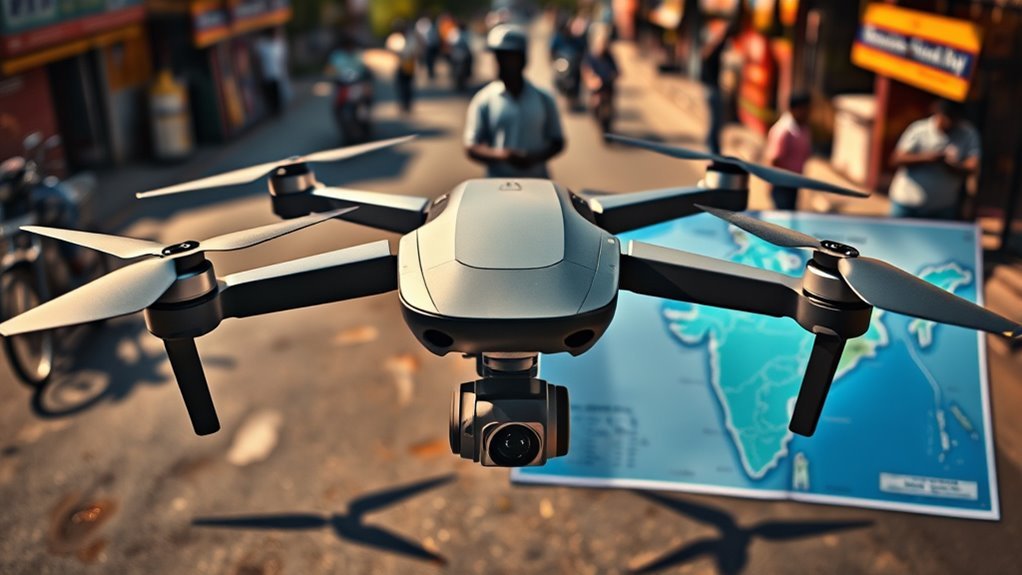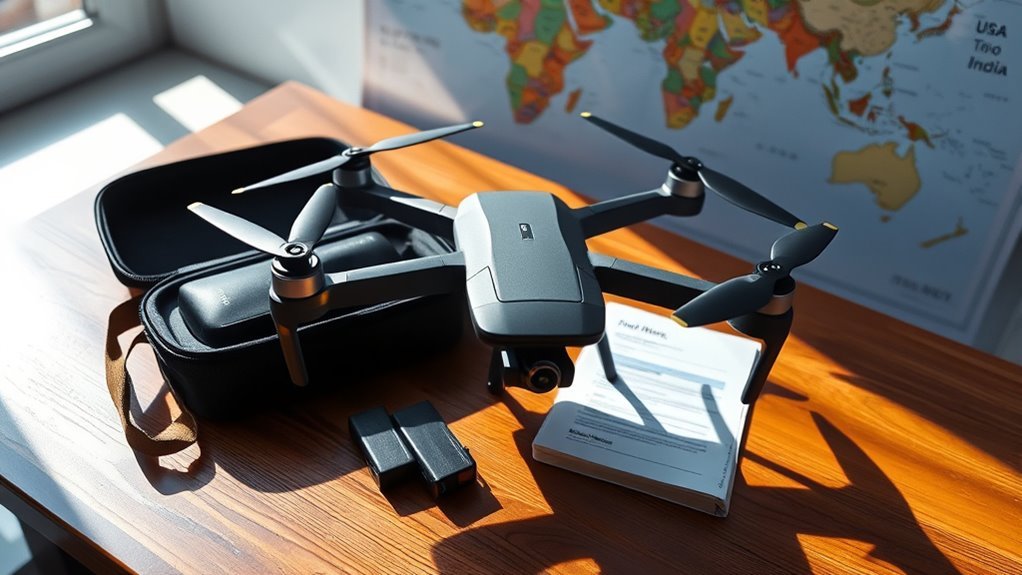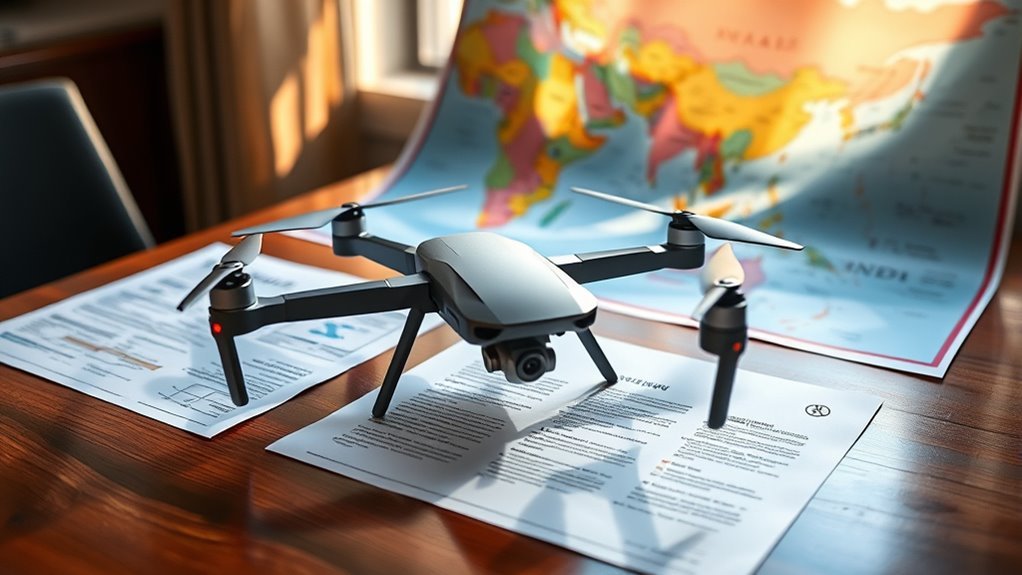Before flying your drone from the USA to India, verify it complies with FAA rules—register it, confirm weight limits, and avoid no-fly zones. In India, register your drone on the Digital Sky Platform and get a Unique Identification Number. Pack your drone securely in carry-on luggage, remove batteries for separate screening, and have all documentation ready for customs. You’ll also need to follow airport security protocols for electronics. Follow these steps carefully, and you’ll be set for legal and hassle-free drone travel; you can uncover more detailed tips ahead.
Understanding Drone Regulations in the USA Before Departure

Before you fly with your drone from the USA to India, you need to make sure it complies with the Federal Aviation Administration (FAA) regulations. Start by identifying your drone’s classification and make certain it meets FAA weight restrictions—typically under 55 pounds for most consumer drones. Complete the registration process on the FAA’s website, which is mandatory before any flight. Be aware of no fly zones, including near airports and restricted airspace, to avoid penalties. Check if your drone requires insurance; while not federally mandated, some states enforce insurance requirements. Familiarize yourself with relevant state laws that may impose additional restrictions. Always adhere to FAA safety guidelines to maintain operational freedom while making sure public safety. Following these steps guarantees your drone is legally ready for departure.
Indian Drone Laws and Registration Requirements

While your drone may meet FAA requirements, you’ll need to comply with Indian drone regulations once you arrive. India mandates that all drones, regardless of size or weight, undergo drone registration with the Digital Sky Platform before any drone usage. This process issues a Unique Identification Number (UIN), which you must display on your drone. You’re also required to secure a Remote Pilot License if operating drones above certain weight thresholds or for commercial purposes. Flying zones are strictly regulated—no-fly zones include near airports, international borders, and strategic locations. Make sure you operate within approved areas and altitude limits to avoid penalties. By adhering to these precise rules, you maintain your freedom to fly safely while respecting India’s regulatory framework and airspace security.
Preparing Your Drone for Air Travel

Since drones are subject to strict regulations both in the U.S. and India, you’ll need to confirm your device meets all airline and security requirements before travel. Start your flight preparation by thoroughly inspecting your drone’s hardware and software to guarantee peak performance. Perform necessary drone maintenance such as battery health checks, firmware updates, and verifying that all components function correctly. Confirm your drone adheres to size and weight limits set by the airline. Remove any prohibited accessories or modifications that could trigger security concerns. Keep documentation ready, including proof of registration and compliance certificates, to avoid delays. By approaching flight preparation methodically, you maintain freedom to operate legally and safely while respecting regulatory frameworks on both ends of your journey.
Packing and Carrying Your Drone on a Flight
Anyone planning to bring a drone on a flight from the USA to India must pack and carry it in compliance with airline and security regulations. Use a sturdy drone case that offers protection and easy handling. Carry your drone as carry-on luggage whenever possible to prevent damage and facilitate inspection. Battery safety is paramount: remove lithium batteries from the drone and place them in your carry-on, making sure each battery’s terminals are insulated to prevent short circuits. Airlines typically limit spare battery capacity to 100Wh, with some allowing up to 160Wh with approval. Avoid checking batteries in checked baggage. Clearly label your drone case and batteries, and be prepared to comply with TSA screening procedures. Following these steps guarantees your drone arrives safely, granting you the freedom to fly legally in India.
Documentation and Permissions Needed for International Travel
Before you travel with a drone from the USA to India, you’ll need to secure specific documentation and permissions to comply with both countries’ regulations. First, obtain travel permits from India’s Directorate General of Civil Aviation (DGCA), which governs drone operations. Register your drone with the DGCA if required, guaranteeing you meet all operational criteria. Carry all relevant paperwork, including your drone’s registration certificate and proof of ownership. Additionally, secure drone insurance that covers international use, protecting you against potential liabilities abroad. In the USA, confirm that your drone is registered with the Federal Aviation Administration (FAA) and that you have all necessary export documentation. Having these documents ready guarantees a smooth changeover across borders, letting you enjoy your drone’s freedom while respecting legal frameworks.
Airport Security Procedures for Drones
When bringing a drone through airport security, you’ll need to undergo a thorough screening process similar to other electronic devices. Make certain you have all required documentation ready and declare your drone during security checks to avoid delays. Following these procedures guarantees compliance with both US and Indian regulations for international drone transport.
Drone Screening Process
Although drones are allowed on flights from the USA to India, you’ll need to adhere to strict airport security procedures during screening. Security officials will inspect your drone for compliance with drone safety standards and verify the integrity of drone technology components to prevent hazards. You must remove batteries for separate inspection and guarantee your drone is easily accessible.
| Step | Requirement | Notes |
|---|---|---|
| Drone unpacking | Remove drone from bag | Facilitate thorough inspection |
| Battery handling | Separate batteries for screening | Comply with lithium battery rules |
| Device inspection | Visual and X-ray scrutiny | Check for hidden modifications |
| Security clearance | Approval before boarding | Follow staff instructions precisely |
Stay transparent and cooperative to enjoy hassle-free travel freedom.
Documentation and Declarations
Since drones fall under regulated electronic devices, you’ll need to provide specific documentation and declare your drone at airport security checkpoints. Proper preparation guarantees smooth customs clearance and avoids delays. You’ll want to have these ready to present:
- Proof of drone ownership and model details
- Valid drone insurance certificate
- Purchase invoice or receipt
- Completed customs declaration form
- Any required permits for flying drones in India
Declaring your drone transparently aligns with airport security protocols and respects regulatory frameworks. Keep these documents accessible in your carry-on luggage for inspection. Following these steps grants you the freedom to enjoy your drone adventures without hassle, while complying with international travel regulations. Staying informed about documentation requirements keeps your journey stress-free and legally sound.
Tips for Safe and Legal Drone Use Upon Arrival in India
Before you start flying your drone in India, you’ll need to register it with the Directorate General of Civil Aviation (DGCA) and obtain a Unique Identification Number (UIN). This is mandatory and guarantees your drone is recognized under Indian regulations. Always carry proof of registration and your UIN while operating your drone. To promote safe flying, avoid restricted areas such as airports, military zones, and government buildings. Maintain a visual line of sight and don’t exceed the maximum altitude set by DGCA guidelines. It’s wise to invest in drone insurance to cover potential damages or liabilities, providing peace of mind as you explore Indian airspace. Adhering strictly to local rules protects your freedom to fly while respecting public safety and privacy.

